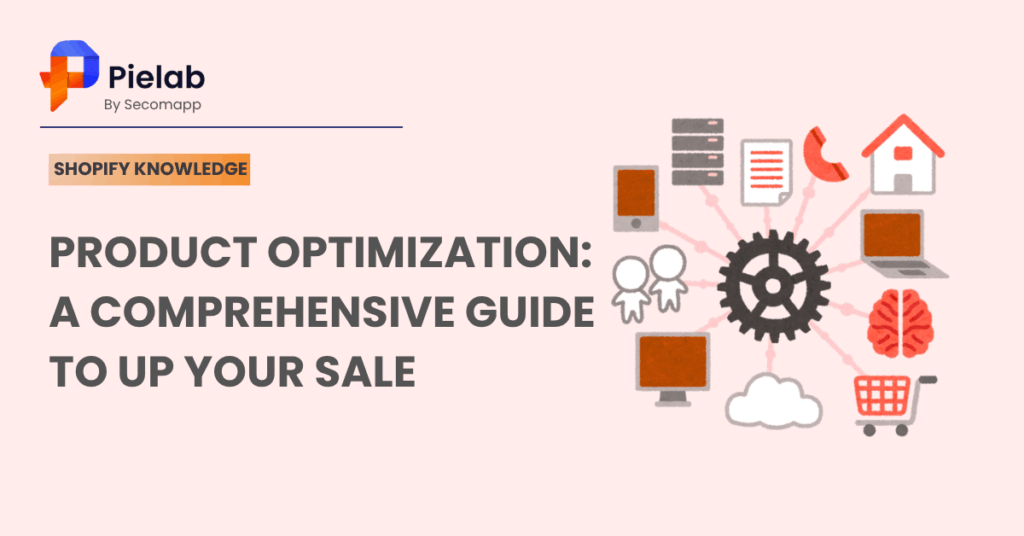Imagine a shopper clicking into your store. If they see unclear titles, poor images, or missing details, they’ll leave within seconds. But with optimized product pages, you guide them smoothly from browsing to checkout, boosting your sales without extra ads.
This guide will provide you with everything you need to know about product optimization: What it is, why it matters, and most importantly, how to make it work for your online business.
What is product optimization?
Product optimization is the process of refining a product to maximize its performance, value, and customer satisfaction. It involves analyzing how customers interact with the product, identifying pain points or areas for improvement, and making adjustments to design, features, pricing, or positioning.
The goal is to ensure the product meets market demand effectively, remains competitive, and drives long-term business growth. Now that we understand what product optimization is, let’s get down to how this can help you grow your sales.

How product optimization boosts your sales
Optimized products with attractive titles and eye-catching images are powerful tools for driving more traffic to a store. They make your products stand out in search results, capture customers’ attention quickly and ultimately drive more traffic from the customers. The more customers come to your store, the more money you might gain from their purchase.
Not only does it help to increase traffic to your store, it can also help reduce bounce rate. Customers tend to abandon online stores if they detect any fraudulent or faulty details in the product display. Therefore, if you optimize your product with appealing product descriptions, clear specifications, and straightforward instructions, the customers will feel less misled and complete their purchase more.
If you put in accurate details, professional visuals, and authentic reviews during product optimization, your store will look more trustworthy. This sense of credibility reassures customers that the store is reliable, encouraging them to make purchases and return in the future.
How to optimize your products
1. Define objectives & success metrics
Defining clear objectives is the first step you can take for your effective product optimization. Optimization plans can be different depending on your business goals, whether it’s improving customer satisfaction, encouraging repeat purchases, or even reducing production costs.

Every goal should be evaluated with success metrics.After choosing a goal, you need to set KPIs for the whole product optimization plan…. For example, if your goal is to increase sales, the right metric would be sales growth or if your focus is on building loyalty, customer retention is a better fit.
2. Research market & customer needs
The second step is to conduct research on your market as well as the customer needs. Conducting research means not only analyzing competitors and industry trends but also studying broader consumer behaviors and emerging opportunities. Once you complete the research, you will identify gaps and acquire the vision to differentiate your products.

Some of the ways you can use to obtain data include: feedback gathered from surveys, market data, customer reviews,… They provide valuable insights into what buyers want and where products may fall short.
Observing how customers use your product in real-life situations is also a good way to collect insights. It helps you spot issues and improvements that may not appear in direct feedback. Together, these insights ensure your optimization efforts are guided by real market demand and customer expectations.
3. Evaluate current product performance
After evaluating your market and customers, you should also carry out an assessment on your current product performance as well. This helps you effectively combine your understanding of the market and your product’s capabilities to come up with improvement ideas.You can review the sales data. It will show how well your product performs in terms of demand and growth. If you see strong sales for a product with certain features, it is best to highlight the product features that you think may resonate with customers while stagnant or declining sales numbers indicate weaknesses that need improvement.

Return and refund rates help you to evaluate your product as well. It reveals whether the product is meeting customer expectations. Low return and refund rates suggest that the product quality and accuracy is great, whereas high ones often point to issues that the product may have such as misleading descriptions, defects, or unmet needs.
Customer support tickets that are submitted directly to you are organic, resourceful data for product evaluation. It reveals valuable information about your product’s strengths and weaknesses that you didn’t see when you first planned and worked on your product. After all, multiple points of view is better than a single view only.
4.Brainstorm improvement ideas
Now that you have your fair share of research and evaluation, let’s get down to brainstorming. Once you’ve identified strengths and weaknesses, the next step is to brainstorm how the product can be improved.
Enhancements may focus on quality, features, usability, or even packaging. Small adjustments in these areas can make a big difference in how customers perceive and use your product.Cost optimization is another valuable angle to explore. This doesn’t mean cutting corners, but rather finding ways to source cheaper materials, streamline production, or reduce waste without lowering the quality customers expect. Keeping value high while managing costs strengthens both customer satisfaction and profit margins.

You can also consider expanding your offer with add-ons, product variations, or bundling strategies. These options not only create more choice for customers but can also increase average order value and encourage repeat purchases by meeting a wider range of needs.
5. Develop & test improvements
After brainstorming ideas, the next step is to develop and test improvements before rolling them out fully. Prototyping allows you to experiment with changes such as a new design, an updated formula, or added features, giving you an effective way to evaluate potential enhancements.
Once a prototype is ready, run small-scale tests with a sample group or through a limited market launch. This controlled approach reduces risk while providing real-world insights into how customers respond to the changes.

Finally, collect feedback and measure the results against your chosen KPIs. Comparing actual performance with your goals helps you determine whether the improvements deliver the intended value and are ready for broader implementation.
6. Implement & scale
Once improvements have been tested and proven successful, the next step is to roll them out across full production and distribution. This ensures that every customer experiences improvement and benefits from it.

It’s also important to prepare your sales and support teams by training them on new features, updated positioning, or any changes that affect customer experience. Well-informed teams can confidently explain the improvements and address customer questions more effectively.
Finally, update your marketing to highlight the new value your product offers. Adjusting messages across ads, product pages, and promotional campaigns draws attention to the changes, helping customers understand the benefits and increasing the likelihood of adoption and repeat purchases.
7. Monitor & continuously optimize
Optimization doesn’t end once improvements are implemented. It requires ongoing attention to maintain growth. Tracking long-term performance with updated KPIs helps you see whether the changes continue to deliver results or if adjustments are needed.

You should also stay alert to evolving customer needs and competitor moves. Markets shift quickly, so products that perform well today may fall behind if they don’t adapt to new expectations or industry trends.
By treating optimization as an ongoing cycle rather than a one-time effort, you ensure that your product remains relevant, competitive, and aligned with customer demand over the long run.
Conclusion
Product optimization is more than just fine-tuning. It’s a strategy that directly impacts customer satisfaction, trust, and long-term sales growth. By defining clear objectives, researching customer needs, evaluating performance, and continuously improving, you ensure your products stay competitive and valuable in a changing market.
Follow this guide and put each step into action to watch your sales grow and your business thrive.

